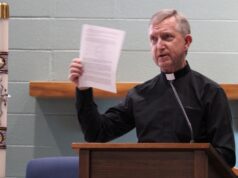
“Hail, full of grace! The Lord is with you.” They are simple words, but full of mystery and meaning, telling us so much about God’s loving plan of salvation for mankind — and Mary’s singular place in that plan.
In keeping with that singular place, the angel’s address to her is also unique. “The angel greeted Mary with a new address, which I could not find anywhere else in Scripture,” wrote the great third-century theologian Origen. “This greeting was reserved for Mary alone.”
To be full of grace is to be favored; even more, it is to be filled with the actual life and holiness of God. To be holy is to be set apart; the call to holiness, the Catechism of the Catholic Church states, is summarized in Jesus’ words: “Be perfect, as your heavenly Father is perfect” (No. 2013; Mt 5:48).
Mary’s holiness comes from the same source — the Triune God — as the holiness that fills all who are baptized and are in a state of grace. But Mary’s relationship with the Triune God is unique, as Luke makes evident in his description of Gabriel’s appearance: “The Holy Spirit will come upon you, and the power of the Most High will overshadow you. Therefore the child to be born will be called holy, the Son of God” (Lk 1:35).
Mary possessed perfect faith, itself a gift from God, and so cooperated perfectly with the three Divine Persons: overshadowed by God the father, anointed by the Holy Spirit and filled by the son. Because she was chosen by God to bear the one in whom the “whole fullness of deity” would dwell (CCC No. 484), Mary is rightly called the mother of God.
She is also the mother of the Church. Faithful and holy, she was chosen so others can also be chosen and made holy, transformed by her son into the sons and daughters of God and joined to the Body of Christ.
This incredible truth is due to her perfect union with her son: “Mary’s role in the Church is inseparable from her union with Christ and flows directly from it” (CCC No. 964).
Mary, the mother of God, is also the first disciple of her son, the incarnate Word, to whom she always points: “Do whatever he tells you” (Jn 2:5). She, for her part, pondered and contemplated all she saw and heard: “And Mary kept all these things, reflecting on them in her heart” (Lk 2:19).
Her perfect obedience, as the early Church fathers often noted, demonstrated that she was the new Eve, whose obedience and gift of self overturned the sin and rebellion of the first Eve. And Jesus is the new Adam, who comes to give everlasting, supernatural life and heal the mortal wound inflicted by the sin of the first Adam (cf. 1 Cor 15:45).
Mary continues to quietly beckon all of humanity to gaze upon and worship the Christ child. Jesus waits with merciful kindness for mankind to recognize him as Lord and Savior. However, he doesn’t just wait for us — he comes to us. He reveals himself to us. But this coming and revelation each await completion, both in our individual lives and in the life of the world. Again, it is the example of Mary, assumed into heaven, which demonstrates that the end is not so far off.
Our lives, in the light of eternity, are quite brief. But what we do with them has eternal consequences. Mary’s words of humility and faith provide guidance as we approach the birth of Christ and consider his eventual return in glory: “Behold, I am the handmaid of the Lord. May it be done to me according to your word” (Lk 1:38).
Carl E. Olson is editor of Catholic World Report and Ignatius Insight.
•••
The Dialog provides readers news to your inbox with the Angelus e-newsletter. Sign up here for a free subscription to the Angelus.







